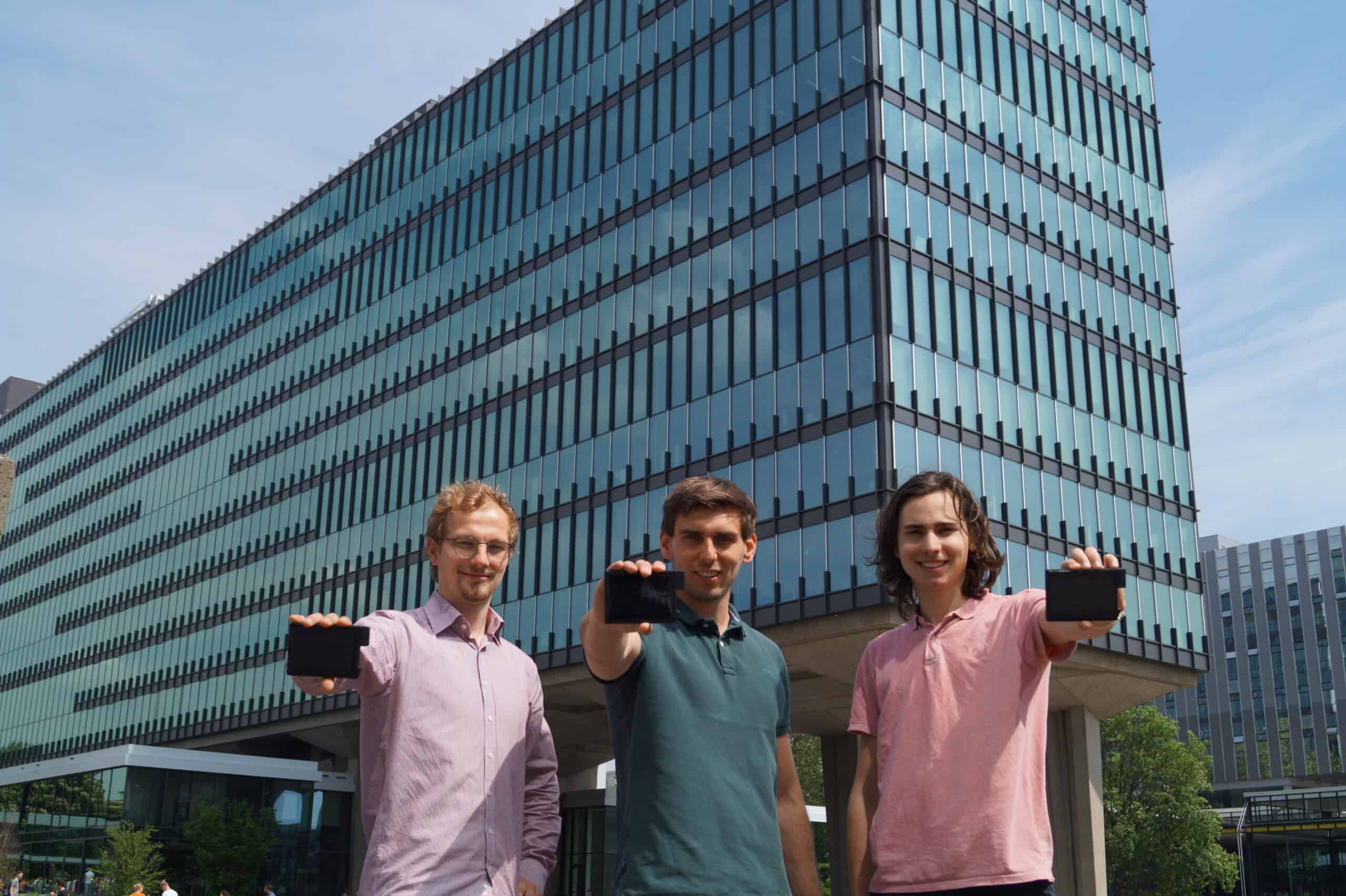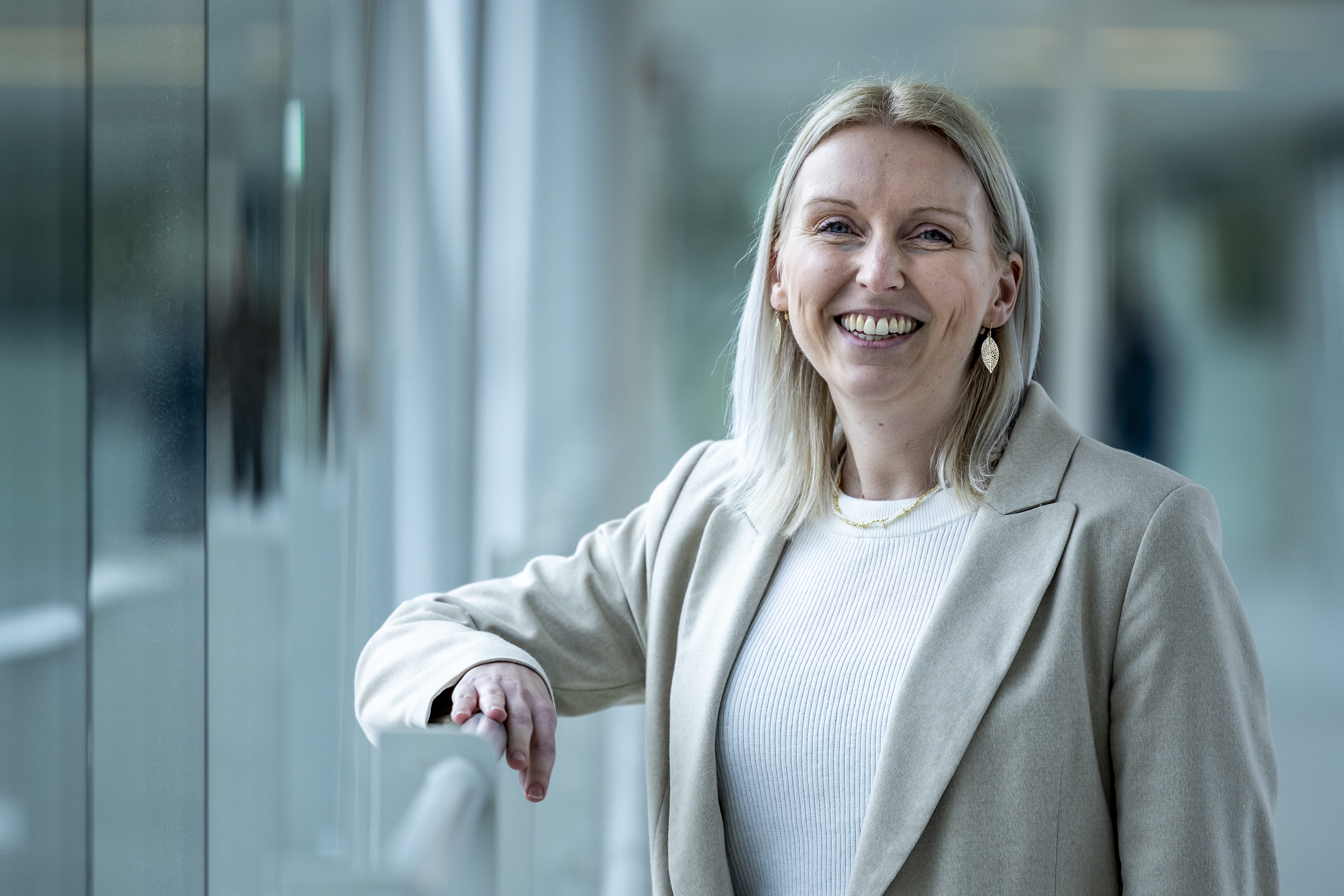
When do windows of an office building need to washed? Does the facade alongside a highway get dirty as quickly as the facade where trains pass by? Questions that might strike you as somewhat boring, says Jeroen Sassen, founder of start-up Heimdall Sensor Intelligence (HSI). “But a lot can be gained from predictive maintenance.” Together with Gijs Derks and Joris Dalderup, Sassen is developing sensors that can be used to tell if it’s time to wash the windows. The start-up was at the Finnish start-up event Slush last week.
The three bumped into each other during a university project that took place at the Eindhoven University of Technology (TU/e). “During that project, the focus was mainly on working on the technology. However, the application for it wasn’t there yet.” The project came to an end, but Dalderup, Derks and Sassen wanted to carry on with it. They saw potential for applications in the maintenance of buildings. Eventually they came to an agreement with the university and set up their company.
An incredible waste
If you look at the maintenance on the exterior of a building, it is often done periodically and at set intervals, Sassen explained. To cite an example, Sassen spoke with a building manager at the Bijenkorf department store. “As we walked around the building, he told us that every seven years they replace this, and every eight years they replace that. The building has scaffolding put up once every 10 years.” According to Sassen, “an incredible waste.”
“Why replace material that is still good enough to keep using? Although, of course, you don’t want to replace something too late either. It’s a trade-off between preventive maintenance and needless replacements. For example, weighing up the cost of a new bitumen roof against the risk of leaks. An informed decision will save you not only in terms of costs, but materials as well. It was with that ‘sustainability drive’ in mind that we wanted to press ahead with the technology.”
After conducting market research, the team settled on window maintenance. “In the long run, we also want to look at, for one thing, replacing bitumen on roofs, and measuring concrete rot, vibrations in a building and the fire resistance of walls.”

Bank card
The principle is the same for all of its applications. A holder the size of a bank card contains a sensor. You mount that holder on the inside of the window. Sassen: “It will then stay there for about twenty years.”
So for the time being, the start-up is focusing on windows. The sensor measures dirt on a window a few times a day. The sensor extrapolates that data for the area surrounding it. “You can predict when it’s time to clean the window panes. That way, you can call in a cleaning crew at the right time. You save water, use less chemicals and fewer staff hours are needed.”
A thousand eyes
“Our end goal is that the casing of the sensor works a bit like a shopping cart. With all kinds of sensors on the shelves, so to speak. We look at each customer’s own needs. You then combine those sensors inside the casing and supply them to the customer. This way, you can leave the planning of maintenance of your building up to that little box. You can do everything in a way that is completely data-driven.”
A sort of gatekeeper, Sassen notes. That is what the name of the company refers to. In Norse mythology, Heimdall is one of the gods who keeps an eye on all the earth’s processes, Sassen says. “The god with a thousand eyes. We want to do the same with our sensors: keep a watchful eye on all maintenance processes.”
High-rise buildings
Buildings such as the Kennedy Tower in the Dutch city of Eindhoven, a healthcare facility building in the northern part of the Netherlands, the Johan Cruiff Arena, a building on the High Tech Campus, and Eindhoven Airport are all showing interest. HSI is installing its sensors there. “Initial talks are also underway with ASML in Veldhoven and the World Trade Centre at the Zuidas in Amsterdam.”
HSI is working in partnership with cleaning company CSU and construction company BAM. It was with these companies that the start-up received a grant of 50,000 euros. Among other things, the start-up is using that grant to make a mold. ” We can use this to manufacture the casing of the devices on a much larger scale – and consequently with much lower costs.”
Soon Sassen will pay a visit to the Dutch consulate in New York. “Previous tests have shown that there is a huge difference between pollution on lower floors and on higher floors. The higher your building is, the more interesting it is because this magnifies the differences in the levels of dirt. With the amount of high-rise buildings in America, the US market is bound to be incredibly interesting.”
Einstein and Einstein
Sassen is primarily concerned with market demand and product scalability within the company. He is (almost) finished with his Operation Management and Logistics studies (he had his final exam just before the interview), “which is mainly concerned with the optimization of business processes.”
For Sassen, what Dalderup and Derks contribute is indispensable to the success of the start-up. “Gijs and Joris are Einstein and Einstein to me. They are both completely focused on the technology. Sometimes Joris even works through the night. Once this application is fully developed, they will start looking for a new one.”
Dalderup is studying Applied Physics and Electrical Engineering. He has also been scouted by ESA, the European Space Agency. He works there on sensors for pinpointing rockets to the nearest centimeter at an altitude of 100 kilometers. Derks has a double major in Systems & Control and Nuclear Fusion. He is now doing his PhD and has since taken a step back. “At the moment, he is primarily working on the patent application within our team.”
Connections
The start-up has an office in the Alpha building on the university grounds. Also located there is The Gate, the incubator organisation of Eindhoven. From The Gate, Monique Greve and Rick Bonants coach and support the entrepreneurs. “Monique has known us ever since our student project. Every now and then she drops in for a cup of coffee and asks how we’re doing. We always feel extra motivated when she visits.”
“Rick is mainly helping us with the business side of our start-up.” For example, Bonants helped Sassen with his pitch at the European Venture Program in Lausanne and Copenhagen. Sassen eventually won the finals in which seventeen other start-ups participated.
Sassen also took part in the LOAD program, the start-up program run by the Gate. “We TU/e students simply want to make it – we just go all out for it. Over the course of that program, you learn how to conduct research into what people are willing to pay for, how much they are currently paying for something, and how are they fixing things at the moment.” Since the start-up focuses mainly on large buildings and as the real estate world is an unfamiliar one for the initiators, Sassen enlisted the help of Ramon van Stekelenborg, director of the Eindhoven branch of the real estate company Collier. “Ramon is helping us with insider insights and important connections within the real estate market.”

Slush
Freek Welsenis, founder of start-up Hable, is a friend of Sassen’s. ” His company is skyrocketing right now. I often ask him for advice. He joined us at Slush last year. I asked him if coming along would be something he’d like to do. He said, ‘Super cool, tagging along is great no matter what.’ We really felt like we had to be there.”
On his return, Sassen let it be known that he “enjoyed it immensely.” “I am extremely grateful to have been able to join this trip. It was inspiring to travel with a Dutch delegation made up of 170 people and 72 start-ups. We spent all of Tuesday and Wednesday in the company of the Dutch delegation. This helped everyone get “warmed up” for the event. That enthusiasm definitely exuded from our stand. This is a fantastic kick-off to the start of our investment round. Which is what I will be focusing on over the coming period.”







